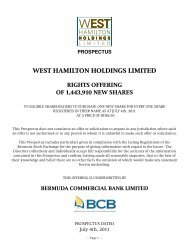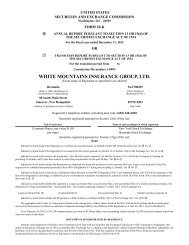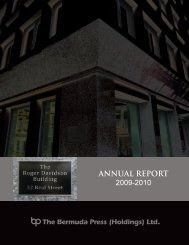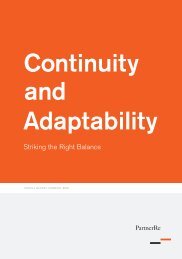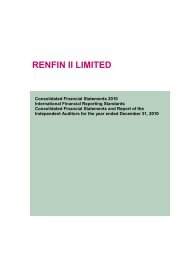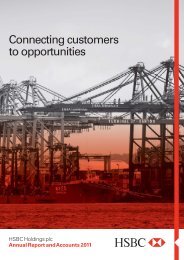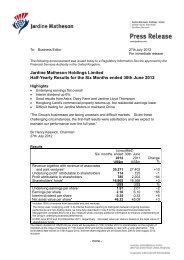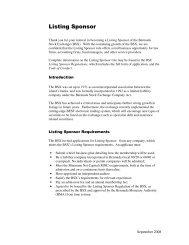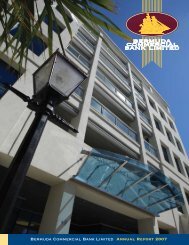Hongkong Land Holdings Limited - Bermuda Stock Exchange
Hongkong Land Holdings Limited - Bermuda Stock Exchange
Hongkong Land Holdings Limited - Bermuda Stock Exchange
Create successful ePaper yourself
Turn your PDF publications into a flip-book with our unique Google optimized e-Paper software.
Notes to the Financial Statements<br />
1 Principal Accounting Policies continued<br />
Dividends<br />
Dividends proposed or declared after the balance sheet date are not recognised as a liability at the balance sheet date.<br />
Revenue recognition<br />
Revenue is measured at the fair value of the consideration received and receivable and represents amounts receivable for goods<br />
and services provided in the normal course of business, net of discounts and sales related taxes.<br />
i) Revenue from sale of properties is recognised on the transfer of significant risks and rewards of ownership, which generally<br />
coincides with the time when the properties are delivered to customers.<br />
ii)<br />
Receipts under operating leases are accounted for on an accrual basis over the lease terms.<br />
iii) Revenue from rendering of services is recognised when services are performed, provided that the amount can be<br />
measured reliably.<br />
iv) Dividend income is recognised when the right to receive payment is established.<br />
2 Financial Risk Management<br />
Financial risk factors<br />
The Group’s activities expose it to a variety of financial risks: market risk (including foreign exchange risk, interest rate risk and<br />
price risk), credit risk and liquidity risk.<br />
The Group’s treasury function co-ordinates, under the directions of the Board of <strong>Hongkong</strong> <strong>Land</strong> <strong>Limited</strong>, financial risk management<br />
policies and their implementation on a group-wide basis. The Group’s treasury policies are designed to manage the financial<br />
impact of fluctuations in interest rates and foreign exchange rates and to minimise the Group’s financial risks. The Group uses<br />
derivative financial instruments, principally interest rate swaps, cross-currency swaps and forward foreign exchange contracts as<br />
appropriate for hedging transactions and managing the Group’s assets and liabilities in accordance with the Group’s financial risk<br />
management policies. Financial derivative contracts are executed between third party banks and the Group entity that is directly<br />
exposed to the risk being hedged. Certain derivative transactions, while providing effective economic hedges under the Group’s<br />
risk management policies, do not qualify for hedge accounting under the specific rules in IAS 39. Changes in the fair value of any<br />
derivative instruments that do not qualify for hedge accounting under IAS 39 are recognised immediately in profit and loss account.<br />
It is the Group’s policy not to enter into derivative transactions for speculative purposes. The notional amounts and fair values of<br />
derivative financial instruments at 31st December 2011 are disclosed in Note 25.<br />
i) Market risk<br />
Foreign exchange risk<br />
Entities within the Group are exposed to foreign exchange risk from future commercial transactions, net investments in<br />
foreign operations and net monetary assets and liabilities that are denominated in a currency that is not the entity’s<br />
functional currency.<br />
Entities in the Group use forward foreign exchange contracts in a consistent manner to hedge firm and anticipated foreign<br />
exchange commitments and manage their foreign exchange risk arising from future commercial transactions. The Group does<br />
not usually hedge its net investments in foreign operations except in circumstances where there is a material exposure arising<br />
from a currency that is anticipated to be volatile and the hedging is cost effective. Group companies are required to manage<br />
their foreign exchange risk against their functional currency. Foreign currency borrowings are swapped into the entity’s<br />
functional currency using cross-currency swaps except where the foreign currency borrowings are repaid with cash flows<br />
generated in the same foreign currency. The purpose of these hedges is to mitigate the impact of movements in foreign<br />
exchange rates on assets and liabilities and the profit and loss account of the Group.<br />
Currency risks as defined by IFRS 7 arise on account of monetary assets and liabilities being denominated in a currency that<br />
is not the functional currency. At 31st December 2011, there are no significant monetary balances held by group companies<br />
that are denominated in a non-functional currency. Differences resulting from the translation of financial statements into the<br />
Group’s presentation currency are not taken into consideration.<br />
Since the Group manages the interdependencies between foreign exchange risk and interest rate risk of foreign currency<br />
borrowings using cross-currency swaps, the sensitivity analysis on financial impacts arising from cross-currency swaps is<br />
included in the sensitivity assessment on interest rates under the interest rate risk section.<br />
32 <strong>Hongkong</strong> <strong>Land</strong>




